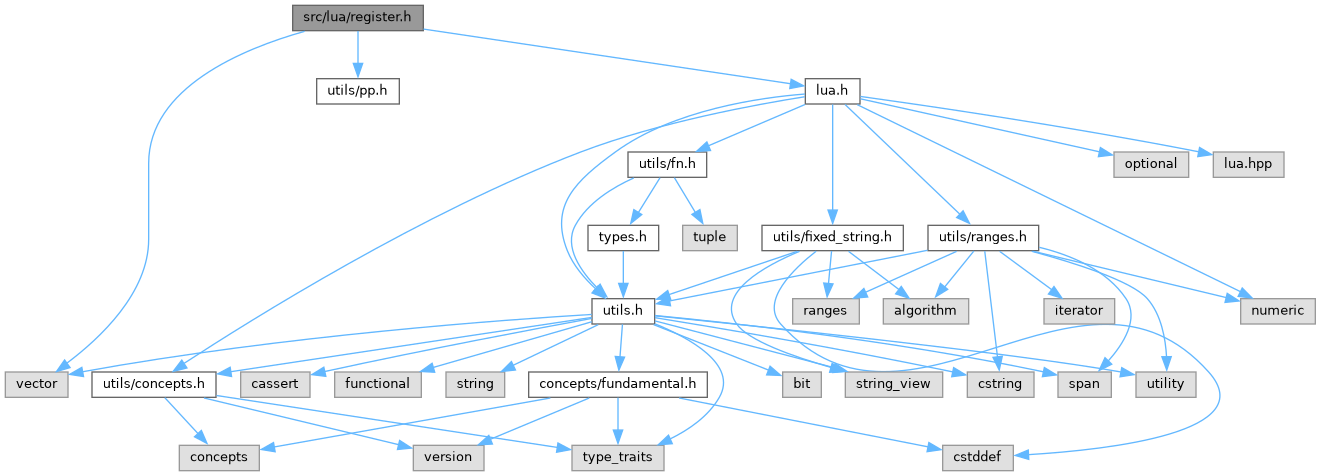Functions/macros for registering user types. More...


Go to the source code of this file.
Classes | |
| class | nngn::lua::static_register |
| Registers a function to be executed when the Lua state is initialized. More... | |
Namespaces | |
| namespace | nngn |
| namespace | nngn::lua |
Macros | |
| #define | NNGN_LUA_PROXY(T, ...) NNGN_OVERLOAD(NNGN_LUA_PROXY, T __VA_OPT__(,) __VA_ARGS__) |
| Macro to automatically create and register a user type meta table. | |
| #define | NNGN_LUA_PROXY1(T) NNGN_LUA_PROXY2(T, [](auto){}) |
| #define | NNGN_LUA_PROXY2(T, f) |
| #define | NNGN_LUA_DECLARE_USER_TYPE(T, ...) NNGN_OVERLOAD(NNGN_LUA_DECLARE_USER_TYPE, T __VA_OPT__(,) __VA_ARGS__) |
Declares that T objects should be manipulated as a user type. | |
| #define | NNGN_LUA_DECLARE_USER_TYPE1(T) NNGN_LUA_DECLARE_USER_TYPE2(T, #T) |
| #define | NNGN_LUA_DECLARE_USER_TYPE2(T, N) |
Detailed Description
Functions/macros for registering user types.
The macros NNGN_LUA_DECLARE_USER_TYPE and NNGN_LUA_PROXY can be used to create and automatically register a user data proxy for a type. The first declares that a type is to be pushed/popped as user data and declares its meta table key in the global table. Two versions are available:
NNGN_LUA_DECLARE_USER_TYPE(T)declares the typeTwith key"T"(i.e.#T).NNGN_LUA_DECLARE_USER_TYPE(T, "U")uses a different name for the meta table, also useful when the argument has other characters (e.g. namespace qualifiers).
The macro NNGN_LUA_PROXY defines the members of the meta table. It takes as parameters the type (T) and a function which will be called to register the members:
The second line will arrange for the registration function to be called when the state is initialized (see nngn::lua::static_register). The nngn::lua::table_view argument is a reference to the meta table which will be:
- automatically initialized and placed in the global table prior to the execution of the registration function
- set for all user data objects of type
Tpushed onto the stack
NNGN_LUA_PROXY only needs to be called once for each type (the registration must be performed at run time before any user data values are used). NNGN_LUA_DECLARE_USER_TYPE has to appear in every translation unit before that type is used in stack operations.
Below is an example of a registration function:
The following fields are set in the meta table:
constantis a Lua number set to the value ofT::constant.accessoris a Lua function which takes aT*and returns a pointer to itsmember_objmember (note thatSalso has to be registered as a user type in this case).value_accessoris a Lua function which takes aT*and returns (a copy of) itsmember_objmember by value.member_fnis a Lua function which takes aT*and afloat(i.e. the same arguments asT::member_fn) and returns anint(the return value of the same function).lambdais a Lua function which takes twolua_Numbers (one converted tofloat) and returns alua_Number(a regular function or function pointer could also be used).c_fnis a Lua function implemented as alua_CFunction. No special treatment of arguments or return values is done.
Note that these macros declare members of the nngn::lua namespace, so they should appear in the global namespace. They do not affect the name resolution of T itself, it will be resolved as if it had been used just outside the macro calls.
Macro Definition Documentation
◆ NNGN_LUA_DECLARE_USER_TYPE
| #define NNGN_LUA_DECLARE_USER_TYPE | ( | T, | |
| ... ) NNGN_OVERLOAD(NNGN_LUA_DECLARE_USER_TYPE, T __VA_OPT__(,) __VA_ARGS__) |
Declares that T objects should be manipulated as a user type.
Required for stack operations involving user data values of this type. A second optional parameter N can specify the name (default: #T).
- See also
- NNGN_LUA_PROXY Can be used to register the user type meta table.
◆ NNGN_LUA_DECLARE_USER_TYPE1
| #define NNGN_LUA_DECLARE_USER_TYPE1 | ( | T | ) | NNGN_LUA_DECLARE_USER_TYPE2(T, #T) |
◆ NNGN_LUA_DECLARE_USER_TYPE2
◆ NNGN_LUA_PROXY
| #define NNGN_LUA_PROXY | ( | T, | |
| ... ) NNGN_OVERLOAD(NNGN_LUA_PROXY, T __VA_OPT__(,) __VA_ARGS__) |
Macro to automatically create and register a user type meta table.
◆ NNGN_LUA_PROXY1
| #define NNGN_LUA_PROXY1 | ( | T | ) | NNGN_LUA_PROXY2(T, [](auto){}) |